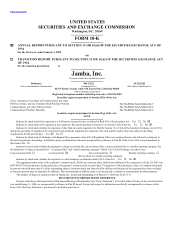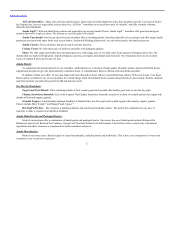Jamba Juice 2008 Annual Report Download - page 7
Download and view the complete annual report
Please find page 7 of the 2008 Jamba Juice annual report below. You can navigate through the pages in the report by either clicking on the pages listed below, or by using the keyword search tool below to find specific information within the annual report.
Table of Contents
As of January 1, 2008, we had two multi-unit area developers who have the right to develop additional franchise stores pursuant to multi-unit license
agreements. The exclusive territories covered by these two multi-unit area license agreements are (i) the Hawaiian Islands and (ii) parts of Texas, Kansas and
Missouri. Generally, a franchise agreement is entered into with each area developer with regard to each store opened under a multi-unit license agreement. These
franchise agreements are generally the same as those entered into with franchisees who are not area developers. Even after a multi-unit license agreement expires
or is terminated, the area developer continues to operate the opened stores under each store’s respective franchise agreement, including in most cases its
contractually provided exclusive geographic radius restriction, which is typically one-mile. As of January 1, 2008, there were 75 stores operating under the two
current multi-unit license agreements.
As of January 1, 2008, one of the two multi-unit area developers had contractual commitments to open new franchise stores in their respective territories.
Specifically, as of January 1, 2008, the area developer in parts of Texas, Kansas and Missouri must open 11 more new stores by May 6, 2010, the expiration
date of this multi-unit license agreement. Multi-unit area development agreements can be deemed to be null and void if the terms of the agreement are not
fulfilled. Although the multi-unit developer for the Hawaiian Islands has satisfied its contractual commitment to open new franchise stores, it still has the
exclusive right to open additional new stores through the expiration of its multi-unit license agreement on June 25, 2018.
Under typical multi-unit license agreements, the area developer generally pays one-half of the $25,000 initial fee, or $12,500, for each store required to
be developed upon execution of the multi-unit development agreement as a development fee. Area developers are obligated to finance their own build-out of each
store location according to our specifications.
Notwithstanding the exclusive territorial rights of the two multi-unit area developers, we retain the right to franchise non-traditional stores. As of
January 1, 2008, we have an agreement with Safeway, Inc. for the opening of up to 40 franchise stores within its grocery stores, of which 27 were open.
We carefully screen prospective locations for visibility, traffic patterns, demographics, convenience, and co-tenancy for potential Company Store and
Franchise Store locations. We select locations for new markets by targeting concentrations of early adopters that we believe will try the Jamba experience and
spread positive word-of-mouth about the brand. In addition, we look for high traffic locations within urban areas before eventually spreading the concept to
more suburban settings. Our expansion strategy involves using the hub and spoke model approach, which clusters stores around certain geographic locations.
We believe this approach has the potential to increase brand awareness and improve operating and marketing efficiencies. We believe that the hub and spoke
model helps to reduce costs associated with regional supervision of store operations, increase distribution efficiencies and provides us with the opportunity to
leverage marketing costs over a greater number of stores. In addition, we believe our ability to hire qualified team members is enhanced in markets in which we
are well known.
Our current growth strategy is focused on building relevance and accessibility. We build relevance through product innovation, marketing
communications, the store environment and the customer experience. We build accessibility through new store development, increased throughput and brand
extensions. The goal of building relevance and accessibility is increasing frequency and, as a result, comparable store sales and average unit volumes. At the
same time, we understand that the foundation for growth lies in strong store-level economics. Accordingly, part of our growth strategy is to ensure that we
achieve target metrics in terms of average unit volume, store level cash flow, store level cash flow margin, net cost per unit and cash-on-cash returns.
7




















